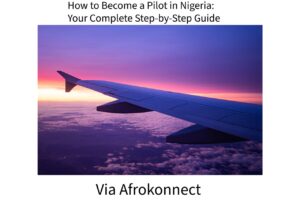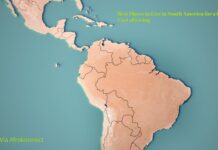
This guide is here to walk you through every stage of that journey. From understanding the types of pilot licenses available in Nigeria, to selecting the right aviation school, and eventually building a career in the skies, we’ll cover what you need to know. Whether you’re fresh out of secondary school or considering a career change, this post offers clarity and guidance to help you take off—literally.
Understanding the Different Types of Pilots in Nigeria
Before starting your pilot training journey, it’s crucial to know which type of pilot you aspire to become. In Nigeria, just like in many other countries, there are three primary types of licenses that determine the kind of flying you’ll be able to do.
The Private Pilot License (PPL) is usually the first license new pilots pursue. It allows you to fly aircraft for personal and recreational purposes, but it does not permit you to fly commercially or earn money as a pilot. Many aviation enthusiasts stop at this level, using their license for weekend flying or personal travel.
The next level is the Commercial Pilot License (CPL), which is the gateway to a professional flying career. With a CPL, you are legally allowed to fly for hire, meaning you can work as a charter pilot, a co-pilot for airlines, or even begin instructing other pilots as you build experience.
Finally, there’s the Airline Transport Pilot License (ATPL), which is the highest level of pilot certification. This license is mandatory for anyone who wants to become a captain or pilot large commercial jets for major airlines. Most pilots obtain their ATPL only after logging hundreds or even thousands of flight hours and passing advanced exams.
Most aspiring airline pilots follow a step-by-step path: starting with the PPL, advancing to the CPL, and then working toward the ATPL as they gain experience in the field.
Step 1: Meeting the Basic Requirements
To begin your journey, you need to ensure you meet the minimum entry requirements for flight training in Nigeria. The age requirement varies slightly depending on the license you’re pursuing—17 years old is the minimum age for enrolling in a PPL course, while CPL applicants must be at least 18 years old.
Your academic background also matters. Flight schools in Nigeria typically require that applicants have at least five credits in their WAEC or NECO results. These credits must include English Language, Mathematics, Physics, and preferably Geography, since these subjects are foundational for understanding aviation concepts.
One critical but often overlooked requirement is medical fitness. All pilots must pass a Class 1 aviation medical examination conducted by a certified medical examiner approved by the Nigerian Civil Aviation Authority (NCAA). This test evaluates your vision, hearing, cardiovascular health, mental wellness, and overall physical fitness to ensure you’re capable of handling the demands of flying safely.
Step 2: Choosing the Right Flight School
Once you meet the initial requirements, the next big decision is where to train. Choosing a reputable and certified flight school is one of the most important steps in your pilot journey. Nigeria has a number of NCAA-approved flight schools, with each offering different programs, training equipment, and environments.
Some of the most recognized institutions in the country include the Nigerian College of Aviation Technology (NCAT) in Zaria, which has decades of experience and is government-run; the International Aviation College in Ilorin, which is known for its modern facilities; and private institutions like Landover Aviation Business School and the Universal School of Aviation, both based in Lagos.
When evaluating these schools, you should look beyond the brand name. Consider factors such as the quality of their aircraft fleet, the qualifications of their instructors, how much hands-on flight time you’ll get, and whether the school provides structured CPL programs or job placement support. Visiting the school in person or speaking with current or former students can give you valuable insight into what to expect.
Step 3: Beginning Your Training
Flight training in Nigeria generally begins with the PPL program, which focuses on basic flying skills, navigation, radio communication, and safety procedures. This stage of training typically takes six to nine months to complete, though it can vary based on your school’s schedule and your own pace of learning.
After obtaining your PPL, you can progress to the CPL program, which is much more intensive. Here, the focus shifts to professional-grade flying skills, including instrument flying, multi-engine aircraft handling, and more advanced aeronautical knowledge. CPL training often takes 12 to 18 months and includes significantly more flight hours and classroom instruction.
The cost of training can vary widely depending on the institution and the type of aircraft used. On average, the full journey from zero to CPL can cost between ₦15 million and ₦30 million or more. Some students choose to complete part or all of their training abroad—in countries like South Africa, the United States, or the Philippines—where costs may be more competitive and access to equipment and facilities more advanced. RECOMMENDED: Best Airlines in Nigeria (Booking Flight Online).
Step 4: Logging Hours and Passing Exams
Flight training isn’t just about getting into the cockpit. You’ll also spend many hours in ground school, learning essential subjects like meteorology, navigation, air law, flight planning, and aircraft systems. This academic component is crucial, and you’ll be tested through both written exams and oral assessments.
In the air, you’ll be required to log a minimum number of flight hours—typically 40 hours for the PPL and over 150 hours for the CPL. These hours include solo flights, cross-country flights, night flying, and instrument flying under the supervision of certified instructors.
At the end of each stage, you’ll undergo a “check ride” or skills test, where an examiner will assess your ability to handle various flight scenarios safely and confidently. You must also pass simulator tests and meet performance standards in real-world flying conditions.
Step 5: Getting Licensed by the Nigerian Civil Aviation Authority
Once you’ve completed your training and passed all the required exams, you’ll need to apply to the Nigerian Civil Aviation Authority (NCAA) for your official pilot license. The NCAA will review your documents, including your flight logbook, medical reports, training records, and examination results.
If everything is in order, they will issue your license—whether it’s PPL, CPL, or eventually ATPL—making you a certified pilot in Nigeria.
Building a Career in Aviation
Earning your CPL is a huge milestone, but it’s only the beginning of your professional journey. To build a long-term career in aviation, you’ll need to continue gaining flight experience and maintaining your skills through recurrent training.
Many new pilots begin by working as flight instructors, helping train newer students while accumulating flight hours. Others join charter companies, agricultural aviation operations, or domestic airlines as co-pilots. These positions help you build the required experience and hours needed to advance to higher roles.
To remain active, you must undergo periodic re-certifications, simulator sessions, and maintain your medical fitness as outlined by the NCAA.
RECOMMENDED:
- Best Domestic Airlines in Nigeria for Cheap Flights.
- 5 Best Flying Schools in South Africa based on Student Reviews
- Best Flight Simulator Software for Beginners
Final Thoughts: Is Becoming a Pilot in Nigeria Worth It?

The path to becoming a pilot in Nigeria is challenging—there’s no sugar-coating that. It demands financial investment, academic dedication, physical and mental discipline, and often a great deal of patience. But for those who are passionate about aviation, every challenge is part of a deeply rewarding journey.
With the Nigerian aviation industry slowly expanding and international travel increasingly in demand, the opportunities for trained pilots continue to grow. And while the initial training might seem expensive or out of reach, it’s important to view it as an investment in a lifelong career that can offer not just good income, but also global mobility, adventure, and purpose.
So if you’ve ever dreamed of taking the controls, guiding an aircraft through the skies, and seeing the world from 35,000 feet—then perhaps now is the time to take your first real step. Because the sky is not the limit. It’s just the beginning.
















[…] Software for Beginners – Your Ultimate Guide, via Afrokonnect. Welcome to the thrilling world of flight simulation! Whether you’re a complete beginner or just getting your wings in virtual aviation, picking the […]